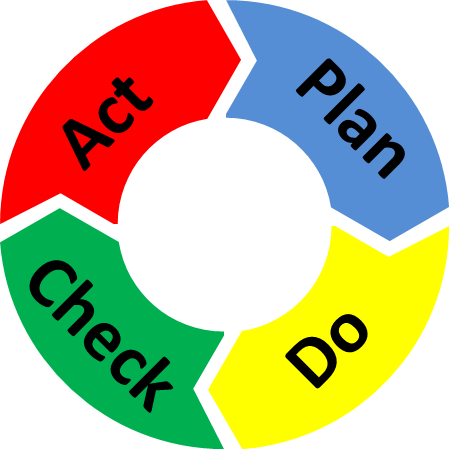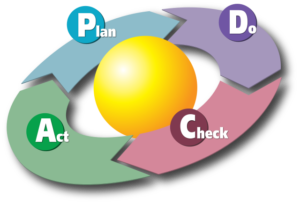Why is the PDCA so effective?
How to Implement the PDCA cycle – The ‘PDCA’ or Deming cycle, Deming circle/cycle/wheel, the Shewhart cycle, the control circle/cycle, or plan–do–study–act is a powerful strategy used in both business and life. It is an improvement process that can be applied to any system or process to help drive continuous creativity, innovation, and improvements. The PDCA cycle is based on scientific methods of problem-solving in manufacturing. The steps of the analysis part of this cycle are Plan, Do, Check and Act.
The Deming cycle or plan-do-check-act (PDCA) is a management and business process. It’s based on the teachings of Dr. W. Edwards Deming and Walter Shewhart of the famous Bell Laboratories in New York. Dr. Deming proposed as part of his quality philosophies that firms should follow a regular and formalized procedure fit or improvement in their performance and increase the effectiveness of their operations.
The Deming Cycle (PDCA) is a continuous, ongoing cycle of improvement that consists of four steps: Plan, Do, Check and Act. This cycle is based on the scientific method, and it was adapted by W. Edwards Deming for business purposes.
We are humans, we are not perfect. We have many challenges like – time, resources, and human resource limitations. But as a human organization, we need to improve our organizational efficiency, internal and external customer satisfaction, and quality. These challenges can be resolved using management tools like the PDCA cycle, used in Lean-Agile Quality Business Leadership
How to Implement the PDCA cycle – How Does PDCA Work?
How to Implement the PDCA cycle – When you want to make sure that your company is constantly improving, it’s important to take a look at why PDCA works and how it can help your business grow. The PDCA has been around for decades and yet some companies are still not using it effectively. It is time to do it right!
Plan-Do-Check-Act (PDCA) is a cyclical approach to continuous improvement. It’s one of the most widely used tools in quality leadership and improvement programs around the world. In fact, it’s so popular that it’s been adopted by many other industries as well, such as healthcare, manufacturing, and education. One of the most important things to remember about PDCA is that it’s a continuous improvement process.
The four steps of PDCA are:
1 – Plan – This step involves defining an objective and identifying potential obstacles that may prevent you from achieving success. It also requires getting input from all stakeholders involved in the project so they’re aware of what’s expected and how they can contribute to reaching goals.
Before you start, you need to have an idea of what you want to achieve, and how you’re going to achieve it. For example, if your goal is to increase sales by 10%, you’ll need a plan for how to achieve this outcome. You might decide to offer a special discount on your products or services or ask customers for referrals.
2 – Do – Once you know what needs doing, it’s time to get started. Run your ideas through the Plan-Do-Check-Act (PDCA) cycle until they work or fail. Make adjustments as needed, then repeat the process until your plans succeed or fail completely.
3 – Check – The best way to check whether your plans are working is by measuring results against objectives set at the beginning of each cycle. If sales haven’t increased by 10%, then clearly something needs adjusting for your plan to succeed! You should also keep track of progress by recording data from each cycle, so you know whether or not things are.
4 – Act – Decide what to do.
How to Implement the PDCA cycle – In summary:
The PDCA cycle is one of the most powerful tools in quality management, and it can be used to improve any process. The reason it works so well is that it’s a simple and flexible framework that can be applied to any situation. The steps are:
1 – Plan: Plan on how you’re going to make the change, taking into account all the things that could go wrong. Do your research and make sure you understand what needs to happen before you start.
2 – Do: Make the change happen! Carry out your plan with as few errors as possible. If there are problems along the way, go back to step 1 and re-plan accordingly.
3 – Check: Check whether the change has worked out as expected or not – if not make another plan based on this information and go back to step 2 again (if needed).
4 – Act: Act on any lessons learned from checking at step 3 and repeat steps 1-3 until you’re satisfied with your result
The PDCA cycle has many benefits:
It makes it easy to make decisions based on data and evidence. You can see what has worked in the past and use that information to create plans for the future.
It encourages continuous improvement in all areas of your business. By regularly reviewing your processes and performance metrics, you’ll constantly be looking for ways to improve them — even if it doesn’t seem like there’s room for improvement at first glance.
It promotes teamwork across departments and functions within your organization by ensuring that everyone understands how their work fits into the bigger picture of quality control at your company.
The PDCA is an iterative process, which means that we don’t expect to get it right the first time. It’s a learning process in which we make mistakes, try things, and then improve on them. The PDCA is also highly adaptable because it can be applied to any situation or system.
Why is the PDCA so effective?
How to Implement the PDCA cycle – The PDCA cycle is a powerful way to make improvements and build quality into every step of your production process. It’s also a great way to ensure that your team is always working towards the same goals and that everyone understands how they can contribute to those goals.
Why is the PDCA so effective? The answer lies in its simplicity. In fact, there’s nothing magical about it at all. The reason many companies struggle with improvement initiatives is that they overcomplicate things by adding too many steps or by not focusing on simple improvements that can have dramatic results.
The Importance of PDCA
The PDCA cycle is simple and elegant. You can apply it to all aspects of your life, so you might as well learn and get excited about it. It’s one of the simplest frameworks in any field, but it’s also probably the most powerful because it can help you achieve your goals as effectively as possible and learn how to progress with life.
The PDCA Cycle is a proven way to identify areas that need improvement and fix them. Implementing this cycle can help you stay on top of problems that may emerge in your business, and plan how to tackle each of them. But it also offers a clear framework for growth. By keeping the cycle at the forefront of your mind, you’re forcing yourself to look at what you have, see what works and what doesn’t, and make plans for improvement. And as long as you adhere to the four steps outlined above, it’s hard not to see improvement happening.
With the PDCA cycle, any organization can be made better. It allows companies to track progress, document their processes, and identify areas for improvement. Planning, doing, checking, and adjusting: these steps aren’t difficult or complicated. They’re cyclical, but they can make all the difference in the success of an organization. The cyclical nature of the PDCA cycle fits well with our human brains’ natural tendencies to pursue a pattern of constant change.
Think about the last time you had to get your car serviced: you probably set yourself up for failure by not knowing what services were available. Once you found out what was available, you had to decide which were needed and prioritize them. Next, you either monitored your car’s diagnostics or took it back to the shop for routine service. Finally, after some interval of time passed, you drove back to the shop for regularly scheduled maintenance based on those priorities.
Understanding and Implementing the PDCA Cycle
Understanding and implementing the PDCA step is one of the most powerful tools in Lean Six Sigma. Moreover, the PDCA step can be successfully applied in any situation, whether it is in a production process or for an intangible project.
OPDCA is another version of PDCA where ‘O’ stands for Observe. The Observe is added at the front of the cycle to emphasize the need to observe before creating any plan. The goal of observation is to find out what is really happening and what can be improved.
Isn’t about time to implement PDCA in your companies and businesses?
Books of Prof. Aecio D’Silva



